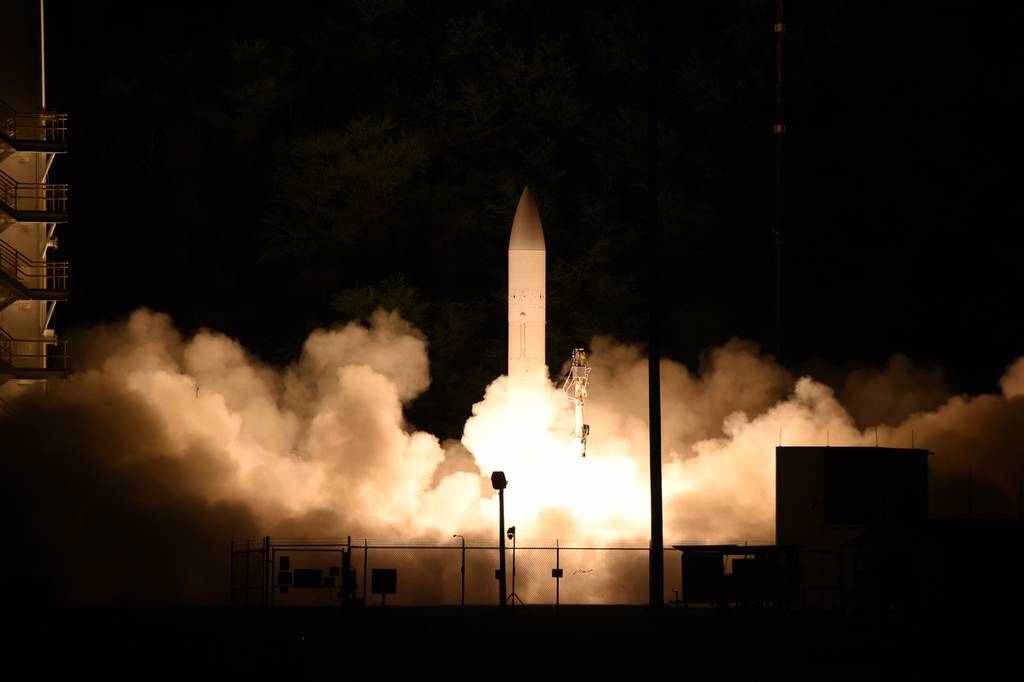
HONOLULU — The United States and Japan signed a cooperative agreement Wednesday to co-develop a hypersonic missile defense capability designed to neutralize hypersonic threats in the glide phase of flight, according to May 15 statements from both the Missile Defense Agency and Japan’s Defense Ministry.
The two countries have been in talks regarding the possibility for well over a year. The MDA is still early in the development process for the Glide Phase Interceptor, and the agency’s budget plan envisions a first fielding in the mid-2030s. Two companies are competing to design GPI – Raytheon Technologies and Northrop Grumman. Each contractor won contracts in June 2022.
During the Japan-U.S. summit meeting in August 2023, the governments announced they had begun working through a cooperative development agreement of GPI.
The interceptors will be designed to fit into the U.S. Navy’s Aegis ballistic missile defense-equipped destroyers. The weapon will fire from the standard vertical launching system and be integrated with the modified Baseline 9 Aegis Weapon System that detects, tracks, controls and engages hypersonic threats.
Defeating a hypersonic weapon in its glide-phase of flight is a challenging technical problem, as the missiles can travel more than five times the speed of sound and can maneuver in flight, making it hard to predict a missile’s trajectory.
The GPI Cooperative Development Project Arrangement falls under the U.S.-Japan bilateral Memorandum of Understanding for Research, Development, Test and Evaluation projects, the U.S. government’s statement notes.
“By pursuing an agreement on GPI development, the U.S. and Japan will strengthen regional deterrence while enhancing longstanding missile defense cooperation between the two countries,” it states.
MDA will continue to lead the development of GPI for the Defense Department. As part of the agreement, Japan will “lead the development of rocket motors and propulsion components of GPI,” the U.S. statement says.
“In recent years, missile-related technologies such as hypersonic weapons have been dramatically improved and significantly enhanced in terms of both quality and quantity in the vicinity of Japan,” the Japanese MOD states in its own release. “Strengthening interception capabilities against these missiles is an urgent issue.”
The U.S. and Japan have previously co-developed, through a similar arrangement, the Raytheon Technologies-manufactured SM-3 Block IIA missile.
While the new cooperative agreement would deliver a GPI capability in the 2030s, Congress last year said, in the fiscal 2024 National Defense Authorization Act, that it wanted to see MDA deliver an initial operational capability by the end of 2029 with a full operational capability by 2032, with at least 24 GPIs delivered by 2040.
Jen Judson is an award-winning journalist covering land warfare for Defense News. She has also worked for Politico and Inside Defense. She holds a Master of Science degree in journalism from Boston University and a Bachelor of Arts degree from Kenyon College.
- SEO Powered Content & PR Distribution. Get Amplified Today.
- PlatoData.Network Vertical Generative Ai. Empower Yourself. Access Here.
- PlatoAiStream. Web3 Intelligence. Knowledge Amplified. Access Here.
- PlatoESG. Carbon, CleanTech, Energy, Environment, Solar, Waste Management. Access Here.
- PlatoHealth. Biotech and Clinical Trials Intelligence. Access Here.
- Source: https://www.defensenews.com/global/asia-pacific/2024/05/15/us-and-japan-sign-agreement-to-co-develop-hypersonic-interceptor/



